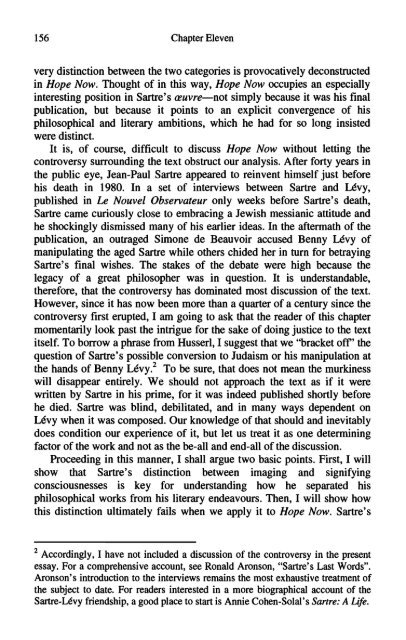Sartre's second century
Sartre's second century
Sartre's second century
Create successful ePaper yourself
Turn your PDF publications into a flip-book with our unique Google optimized e-Paper software.
156 Chapter Eleven<br />
very distinction between the two categories is provocatively deconstructed<br />
in Hope Now. Thought of in this way, Hope Now occupies an especially<br />
interesting position in <strong>Sartre's</strong> ceuvre—not simply because it was his final<br />
publication, but because it points to an explicit convergence of his<br />
philosophical and literary ambitions, which he had for so long insisted<br />
were distinct.<br />
It is, of course, difficult to discuss Hope Now without letting the<br />
controversy surrounding the text obstruct our analysis. After forty years in<br />
the public eye, Jean-Paul Sartre appeared to reinvent himself just before<br />
his death in 1980. In a set of interviews between Sartre and Levy,<br />
published in Le Nouvel Observateur only weeks before <strong>Sartre's</strong> death,<br />
Sartre came curiously close to embracing a Jewish messianic attitude and<br />
he shockingly dismissed many of his earlier ideas. In the aftermath of the<br />
publication, an outraged Simone de Beauvoir accused Benny Levy of<br />
manipulating the aged Sartre while others chided her in turn for betraying<br />
<strong>Sartre's</strong> final wishes. The stakes of the debate were high because the<br />
legacy of a great philosopher was in question. It is understandable,<br />
therefore, that the controversy has dominated most discussion of the text.<br />
However, since it has now been more than a quarter of a <strong>century</strong> since the<br />
controversy first erupted, I am going to ask that the reader of this chapter<br />
momentarily look past the intrigue for the sake of doing justice to the text<br />
itself. To borrow a phrase from Husserl, I suggest that we "bracket off the<br />
question of <strong>Sartre's</strong> possible conversion to Judaism or his manipulation at<br />
the hands of Benny Levy. 2 To be sure, that does not mean the murkiness<br />
will disappear entirely. We should not approach the text as if it were<br />
written by Sartre in his prime, for it was indeed published shortly before<br />
he died. Sartre was blind, debilitated, and in many ways dependent on<br />
L6vy when it was composed. Our knowledge of that should and inevitably<br />
does condition our experience of it, but let us treat it as one determining<br />
factor of the work and not as the be-all and end-all of the discussion.<br />
Proceeding in this manner, I shall argue two basic points. First, I will<br />
show that <strong>Sartre's</strong> distinction between imaging and signifying<br />
consciousnesses is key for understanding how he separated his<br />
philosophical works from his literary endeavours. Then, I will show how<br />
this distinction ultimately fails when we apply it to Hope Now. <strong>Sartre's</strong><br />
Accordingly, I have not included a discussion of the controversy in the present<br />
essay. For a comprehensive account, see Ronald Aronson, "<strong>Sartre's</strong> Last Words".<br />
Aronson's introduction to the interviews remains the most exhaustive treatment of<br />
the subject to date. For readers interested in a more biographical account of the<br />
Sartre-Levy friendship, a good place to start is Annie Cohen-Solal's Sartre: A Life.
















